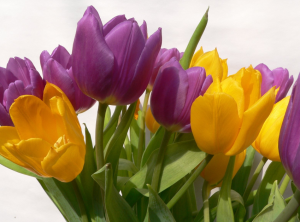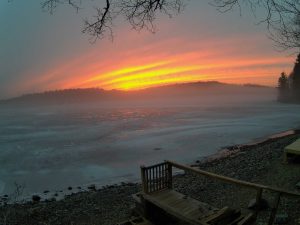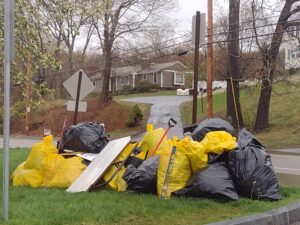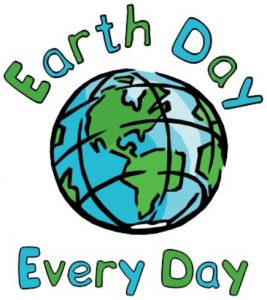Buffer Zones
Importance of Buffer Zones

Although we cannot all be limnologists (lake scientists), we encourage everyone that lives on our lake to learn some basics that can make a difference in our long-term water quality. Vegetated buffers, or areas of vegetation situated between the built environment and the water, trap sediments, excess nutrients, and other pollutants, prevent erosion, and help to stabilize sloped areas and the shoreline. Pollutant removal is most effective when runoff is directed as slow, diffuse flow through a vegetated margin along the shoreline. Nutrients, principally phosphorous, will accelerate eutrophication, which will eventually turn our lake into a meadow similar to some of the Stockwell Ponds. Phosphorous also fertilizes our non-native plant species and algae causing us to increase treatments to the lake. If you use fertilizer on your lawn, please use a product with no phosphorous (“0” for the middle number) as has been pointed out in other newsletter articles. Even if you use a lake-friendly fertilizer, a buffer between your lawn and the shore can help remove nutrients and sediments from surface runoff, especially if you have a slope running right down to the water. Currently, all lake-front property owners have septic systems. Even with perfectly performing systems, nutrients including phosphorous will make their way underground to the lake. Trees along the shoreline, with their deep root systems, will remove some of these nutrients and prevent them from entering the lake. Trees also stabilize the soil, deflect rain to reduce erosion, and provide shade for the shallows. If native trees and shrubs already exist along the shoreline, leave them undisturbed. We should all consider improving our buffers. To learn how, please consult the following links to the internet which provide far more excellent information that we can provide in our newsletter. The following links give specific guidance for construction and what are the best trees and plants to utilize.
Why Do We Need Them?
 Where there are humans, there is nutrient pollution. The way we live tends to over-nourish and pollute our environment. Fertilizers wash down over our carefully graded lawns directly to the lake. The oils and greases from our cars are rinsed off our driveways and roads down to the lake. We rest and play along the lake and our foot traffic tramples the vegetation. We park our cars and launch our boats as close as possible to the lake – our heavy vehicles compact the earth until its as hard and impenetrable as asphalt. Our lifestyles are hurting the lake. Vegetated buffers provide a filter and percolation area for the runoff that comes from our home and play areas. The vegetation in the buffer uses the nutrients carried on the stormwater as fertilizer. If the nutrients reach the lake, the aquatic plants will use them and an algae bloom can occur.Vegetated buffers are designed so that nutrients are used by the land vegetation rather than by lake algae. If you own waterfront property, the water quality of the lake directly impacts you. If water quality deteriorates, the value of your property decreases. Boating and swimming through pond scum becomes less attractive. Fish populations can decline or be killed off completely.
Where there are humans, there is nutrient pollution. The way we live tends to over-nourish and pollute our environment. Fertilizers wash down over our carefully graded lawns directly to the lake. The oils and greases from our cars are rinsed off our driveways and roads down to the lake. We rest and play along the lake and our foot traffic tramples the vegetation. We park our cars and launch our boats as close as possible to the lake – our heavy vehicles compact the earth until its as hard and impenetrable as asphalt. Our lifestyles are hurting the lake. Vegetated buffers provide a filter and percolation area for the runoff that comes from our home and play areas. The vegetation in the buffer uses the nutrients carried on the stormwater as fertilizer. If the nutrients reach the lake, the aquatic plants will use them and an algae bloom can occur.Vegetated buffers are designed so that nutrients are used by the land vegetation rather than by lake algae. If you own waterfront property, the water quality of the lake directly impacts you. If water quality deteriorates, the value of your property decreases. Boating and swimming through pond scum becomes less attractive. Fish populations can decline or be killed off completely.
Where Do You Put Them?
 Vegetated buffers need to be placed between people and the lake. We need to filter the stormwater runoff from our houses, garages, driveways, roads (both paved and gravel), and road ditches through flat vegetated areas. Lakeside parking areas and playing fields should drain through a buffer too.
Vegetated buffers need to be placed between people and the lake. We need to filter the stormwater runoff from our houses, garages, driveways, roads (both paved and gravel), and road ditches through flat vegetated areas. Lakeside parking areas and playing fields should drain through a buffer too.
Equally important are the streams which flow into the lake. The also need to be protected by leaving vegetated buffer strips next to them.
More on Buffer Zones...
Related Links









